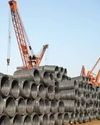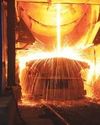The Indian stainless steel industry is looking ahead at a brighter future as use of stainless steel has started moving away from conventional kitchenware and appliances to other sectors such as architectural building and construction, automotive, railways, transport, process and engineering. However, the per capita consumption is still 2 kg against the world average of 6 kg. Moreover, the capacity utilisation has been low due to the pressures of imports. Removal of the import duty on raw materials such as ferro nickel and stainless steel scrap seems to be the need of the hour. Positive government policies will not only give a fillip to the sector but also help in full utilization of the existing plants’ capacities, which in turn will reduce dependence on imports, said K K Pahuja, President, Indian Stainless Steel Development Association (ISSDA) in a free-wheeling interview to Ritwik Sinha. Further, the ISSDA President also stressed on use of stainless steel in construction of railway coaches to reduce loss of life caused by accidents.

The market size of finished steel is around 2.7 million tons (mt). We have an in-built capacity of 6 mt of melt products, of which we had produced around 3.3 mt of melt products in 2016. Although we have a huge amount of idle capacity in the country but we also have imports happening to the tune of 0.5 mt in 2016. Imports majorly happened due to some external factors such as subsidized and unfair trade practices. Recent Government actions of imposing countervailing duty (CVD) and antidumping will bring welcome relief.
Which industries are the top consumers of stainless steel? How has the use of stainless steel as a raw material evolved during the last decade?
Around 50 percent of the produce is consumed by the kitchenware, utensils and appliances sector. However, this segment used be around 80 percent even 10 to 12 years back. But now as the economy is progressing there is a rise in consumption from other sectors such as architectural building and construction, automotive, railways and transport, process and engineering industries. In the last 10 years or so stainless steel consumption has also come up from sectors like diary, pharmaceutical, sugar and nuclear industry. Presently, transport (including Railways) consume around 11 percent of the produce, architecture and construction consume around 8 percent, whereas process industry and engineering application sector both together consume around 30 percent of the annual produce.
What is the annual requirement for stainless steel for India Railways?
Denne historien er fra December 2017-utgaven av Steel Insights.
Start din 7-dagers gratis prøveperiode på Magzter GOLD for å få tilgang til tusenvis av utvalgte premiumhistorier og 9000+ magasiner og aviser.
Allerede abonnent ? Logg på
Denne historien er fra December 2017-utgaven av Steel Insights.
Start din 7-dagers gratis prøveperiode på Magzter GOLD for å få tilgang til tusenvis av utvalgte premiumhistorier og 9000+ magasiner og aviser.
Allerede abonnent? Logg på

Steel's Net Zero mission
The country’s commitment to achieving Net Zero within a targeted timeframe will now propel its steel sector towards a sustainable future in line with global trends.

Fuel Price Hike, Supply Chain Disruption Hurt Festive Sales
Supply chain disruptions and fuel price hikes have hurt festive sales in a big way as most auto majors posted decline in sales in October.

Seaborne coking coal offers remain range-bound
Seaborne coking coal offers moved in a narrow range in October amid global supply tightness and healthy spot demand.

Global crude steel output down 8% in September
China manufactured 74 mt in September, fall of 21% y-o-y while India’s production went up by 7% to 10 mt.

MOIL embarks on expansion projects
“Even though our country is blessed with manganese ore reserves, we import 50% of the domestic requirement. We have to lower our import dependence and save precious foreign exchange.” Ram Chandra Prasad Singh, Steel Minister

Iron ore handled by major ports down 17% in H1
The 12 major Indian ports handled 27 mt of iron-ore during H1 of 2021, down by 17% from 33 mt recorded for the corresponding period of previous year.

Shrinking China output to boost India exports
“In the third quarter of 2021, the company actively responded to the pressure from external policies, such as production curtailment and dual control system on energy consumption and intensity, as well as coal resource shortage and surging prices.” Baoshan Iron and Steel Co Ltd

Indian Railways' iron-ore handling up 25% in H1
Indian Railways in April-September of 2021 (H1) transported 84 mt of iron ore, up by 25% over 67 mt during April-September 2020.

September crude steel production up 7.2% y-o-y
India’s crude steel production in September 2021 grew 7.2 percent to 9.547 million tons (mt) over September 2020 but was down by 3.2 percent from August 2021 output, provisional steel ministry data showed.

“Five enablers: way forward to sustainable cleaner steel”
Right and scalable technology, appropriate policy guidance by government, access to finance to fund transition, willingness of customers to pay for cleaner products and infrastructure for use of new technologies are the need of the hour for the sustainable and cleaner steel industry, according to Madhulika Sharma, Chief Corporate Sustainability, Tata Steel.